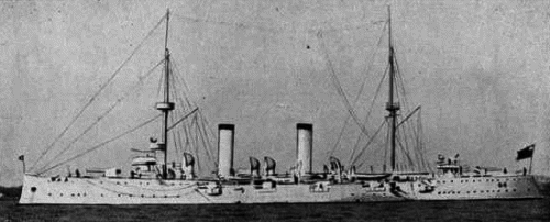
The Chinese German-built cruisers – After the crippling losses of the Sino-Japanese war, and ten years after the losses of the Sino-French war, the Chinese Navy needed to be bolstered again. Due to conflicting intererests with the British and French, China once again ordered several warships to Germany. Two serie of cruisers were orered, the Hai Chi and Hai Yung class. They were all protected cruisers intended for the depleted Beiyang fleet (northern fleet). The Small 2nd class protected cruisers were ordered simultaneously with two larger ships of Hai Chi class at the Vulcan shipyards of Stettin.
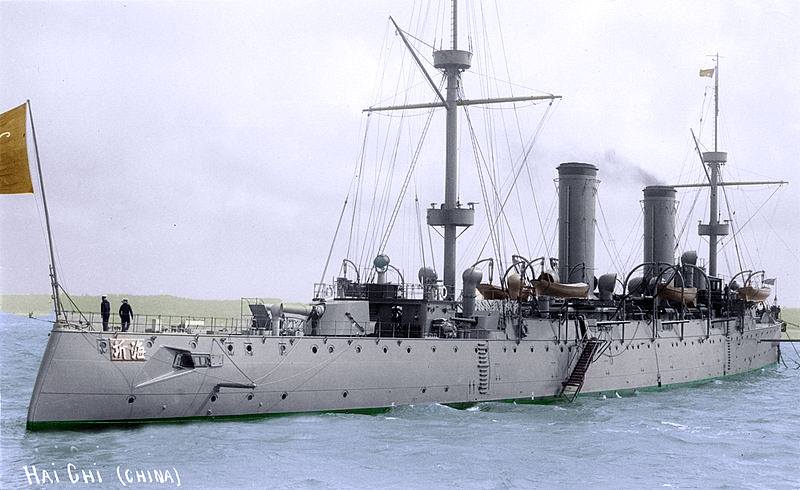
The larger, 1st class protected cruiser Hai Chi for reference (colorized by Irootoko jr. – From Pinterest)
The yard had quite a long history with China and there was mutual trust. Previous ordered also included the first German battleships ever exported, the Dingyuan class ironclads (1881). The Hai Yung class cruisers were launched in 1897-98 and completed in 1898. They served during the 1905 revolution, changing onwers and surviving the war, but fell into disrepair and lack of maintenance. Eventualy they were obsolete in the 1930s and would have been relegated as gunboats, but they were never officially discarded. Insted, they were scuttled on August 1937 like most of the Chinese fleet ships not sunk in the Japanese attack.
Design of the Hai Yung class
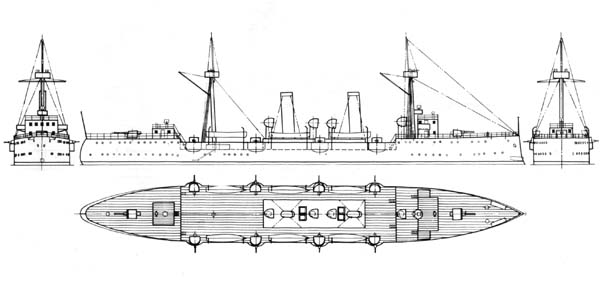
The Hai Yin, yet another cruiser design of that era.
The Hai Chi and Hai Yung class were basically respectively 2nd and 1st class protected cruisers. The design of the Hai Yung class was relatively classic, and designs influences have been the British Apollo class, Italian Regioni class, but overall a close resemblance to the Dutch Gelderland-class cruisers. But overall, the main inspiration seemed to have been the Gazelle class cruisers then in construction. Germany used the Gazelle class as the basis for all light German cruisers before WW1.
The three-staged hull comprised a forecastle, poop and ram-shaped stem. There was a departure from previous designs of heavy, slow firing guns. For these cruisers, the Chinese government choosed to use lighter, but quick-firing 150mm/40 guns, placed in a characteristic “triangular” scheme: Two guns aside on forecastle, third on poop, and this was completed by 105mm and 47mm guns mostly broadside on the upper deck.
Hull & protection
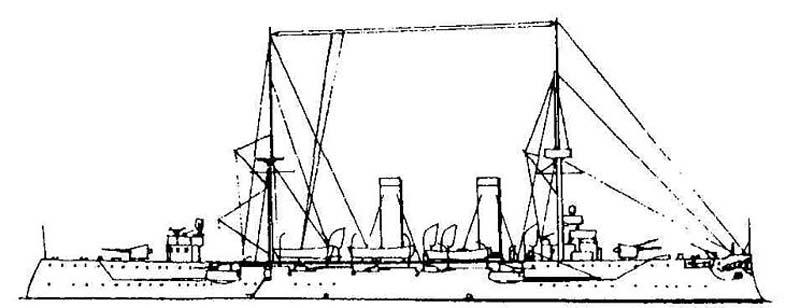
The Hai Yung class was a relatively small protected cruiser, displacing 2680 tons standard for a Length of 328 ft (100.0 m), a beam of 40 ft 9 in (12.4 m) and a draft 19 ft (5.8 m). Protection consisted in an internal deck armour ranging from 2.75 down to 1.5 in (70–38 mm) with sloped sides: The machinery space was protected by 32 mm of deck armour plating with 70 mm slopes which formed a turtleback. At the ship’s ends the armour plating had 25 mm thickness. All gun shields were protected by 2 in (51 mm) and the conning tower was given 1.5 in (38 mm) walls, and for Chinese sources, 50 mm (2 in too). 1.5 in was perhaps the roof.
Powerplant
The cruiser had two a shaft reciprocating VTE steam engine coupled with eight cylindrical boilers which developed 7,500 ihp (5,600 kW). The cruisers carried 200–580 tons coal. Top speed was noted in specifications to be 19.5 knots (22.4 mph; 36.1 km/h). Sea trials in Germany showed the ships could reach the actual figure of 8,400 hp (6,300 kW) on forced heating, and reach 20.75 knots (38.43 km/h). However it could not be maintained long. After arrival, the top speed achieved was 20.25 knots (37.50 kilometers per hour).
Locally, the ships were known as the Hǎiróng class (海容). The crew consisted in 244 officers and sailors.
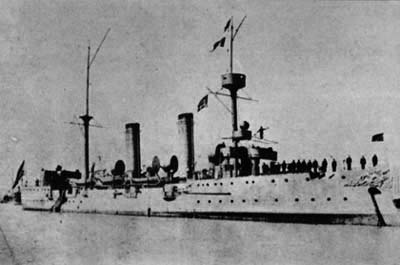
Hai Chen, date unknown
Armament
The Hai Yung class cruisers were armed with three Krupp 5.9 in (15 cm) QF guns placed on the forecastle (two side by side) and a single on the poop. This arrangement gave them ideal traverse.
The secondary armament comprised eight Krupp 105 mm (4.1 in) QF guns and later six 37-mm-Hotchkiss-Autocannons were added. The 10.5 cm guns were placed in sponsons with recesses at each end, and four more behind the broadside walls. The Hotchkiss were placed mostly on the upper deck, with two behind walls, in between the 10.5 cm guns, and two at the prow behind recesses. Two were placed on platforms behind the bridge, and two on platforms above the rear quartedeck house.
This was completed by three submarine torpedo tubes of 14 in (360 mm) caliber, bow and broadside.
In the 1930s the only modernization consisted in adding a single 40/39 2pdr QF Mk II AA gun.

Author’s pofile of the Hai Tien
Specifications
Specifications* |
|
| Dimensions | 100 m x 12.4 m x 5.8 m draft. |
| Displacement | 2,680 tonnes standard -approx. 2,900 tonnes Fully Loaded |
| Crew | 244 |
| Propulsion | 2 shaft VTE, 8 cyl. boilers, 7500 ihp. |
| Speed | Top speed 19.5 knots, 2500? nm range, about 580 tons coal. |
| Armament | 3 x 150 mm (5.9 in), 8 x 105 mm (4 in), 12 x 37 mm QF Hotchkiss. |
| Armor | Decks 70–38 mm, gun shields 51 mm, CT 38 mm. |
Src/Read More
Robert Gardiner (Hrsg.): Conway’s All the World’s Fighting Ships 1860–1905
Arlington, L. C., Through the Dragon’s Eyes (London, 1931)
Wright, R., The Chinese Steam Navy, 1862–1945 (London, 2001)
http://www.navypedia.org/ships/china/ch_cr_hai_yung.htm
https://en.wikipedia.org/wiki/Chinese_cruiser_Hai_Yung
https://commons.wikimedia.org/wiki/Category:Hai_Yung_class_cruiser
https://ww2db.com/ship_spec.php?ship_id=813
https://en.wikipedia.org/wiki/Beiyang_Fleet
https://www.worldnavalships.com/chinese_navy.htm
http://oceania.pbworks.com/w/page/8450927/Chinese%20Cruisers
https://www.quora.com/Why-did-China-have-no-fleet-after-the-Beiyang-fleet-s-destruction
https://commons.wikimedia.org/wiki/Category:Naval_ships_of_Qing_China
Active service of the Hai Yung class 1900-1937
Early service (1898-1903)
On May 4, 1898, the then ambassador to Germany, Lu Haihuan, was present at the sea trial of the Hai Yung, lead ship of the class, showing her reaching more than 20 knots, in fact close to 21 knots, which was excellent. On May 13, the Hai Yung departed for China with a German crew, passed Ceylon on June 28, and arrived in Hong Kong on July 12, then Dagukou on July 27, 1898.
In 1899, the Qing dynasty reorganized the Beiyang naval division, recruiting Beiyang former admirals to replace the commander-in-chief Ye Zugui and choose Sazhen Bing as the commander. The Hai Yung by then was one of the most modern and capable bof the New Beiyang Navy. The Gengzi Incident (The Boxer rebellion) broke out in 1900: Ye Zulun’s fleet was stationed in Tianjin, and the cruiser Hairyung was posted as flagship of the fleet at the Leiyue Wharf in Dagukou. Ye Zulun did not intended to engage the arriving coalition warships, which overwhelmed his forces, so he ordered instead his cruiser to leave Dagukou to comply with the imperative orders of the coalition commander, and drop anchor as the coalition fleet started operations, accepting to be boarded. The “Xin Chou Treaty” was signed avec the rebellion and the the coalition forces released the Hai Yung.
Russo-Japanese war (1904)
When the Russo-Japanese War broke out in 1904, the Beiyang fleet was stationed in Yantai. On August 10, 1904 the Yellow Sea naval battle took place and the Russian Pacific Fleet failed to break through and was trapped in Port Arthur. At 04:15 the following day however a Russian destroyer managed to flee and took refuge in Yantai, surrendering to the Chinese navy. She was disarmed and handed over to the Chinese navy.
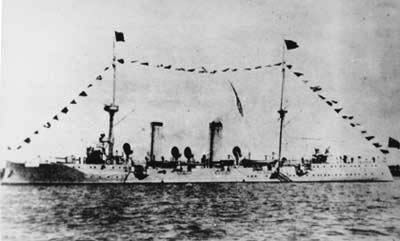
The cruiser Hai Chou
Hai Yung sent a steamboat to take care of her. Meanwhile the battle was over. At 19:30, the Japanese Navy IJN Chao Chao and Xia suddenly entered the port. Sa Zhenbing boarded the Japanese ship to start negotiations, and the Japanese ship were convinced to leave the port. However, at 03:30 the following day, IJN Chao Chao sent a small boat to approach the Russian destroyer, requesting the crew to surrender or be engaged by the Japanese. The situation quickly degenerated as the Japanese attempted to take the Russian ship ion tow, violently opposed by the Russian crew.
The incident was watched by the three cruisers present when two IJN destroyers were sent to forcibly capture ships surrendered to the Chinese navy. Pointing guns on the Chinese vessels. This incident caused an uproar in the Chinese public opinion. On the morning of November 16, the Russian destroyer was broke through her captain did not trust the Chinese Navy’s ability to guarantee neutrality, but after an exchange of letter to the Russian consul it was decided to scuttle her. Hai yung departed for Shanghai afterwards.
On the evening of January 1, 1905, five Russian destroyers and several other vessels broke through from Lushun, and they entered Yantai on January 2. The Hai Yung was rushed to Yantai from Shanghai on January 6, 1905, to watch the Russian ships and respect neutrality. When the Second Pacific Fleet was sighted along the souther Chinese coast, the cruisers Hai Chi, Hai Bian, Hai Yung and Hai Chen patrolled Shanghai waters to prevent the detained Russian ships in Yantai to flee and join the Russian fleet, that could be breach of neutrality. The two sides later signed an armistice agreement and the Chinese navy return the Russian warships. As the autumn came, China ordered 7 Marconi radio stations, of which three were used by the Army, and four installed on the four cruisers (of the Hai Chi and Hai Yung), a first in the Chinese Navy.
The 1906 Goodwill tour of asia
In 1906, the Hai Yung sailed alongside the Hai Chi for a six-month trip through Southeast Asia, making a survey of the living conditions of the Chinese communities abroad. The two cruisers left Shanghai on October 27, 1906, visiting Hong Kong, Manila, Saigon, Bangkok, Singapore, Batavia, Semarang, Soerabaya, Muntok, Bangka and Penang. They returned home via Singapore. In 1908, a new commander of the Chinese fleet was appointed, Admiral Sa Zhenbing. He placed his mark onboard the Hai Chi, and sailed to Amoy with Hai Yung, her sister ships Hai Chou and Hai Chen, and other units, where they received the American Great White Fleet. In 1910 there was another cruiser and visit in Amoy, and Sa Zhenbing attended the ceremonies again.
In 1910, Portugal clashed with the Qing Dynasty over a border issue related to Macau. The Portuguese claimed that if China did not agree to expand Macau’s borders there would be naval escalation, Portuguese warships and even likely to shell China’s coastal cities. Hai Yung and Hai Ban were dispatched in the area as a show of strength in Macau, forcing Portugal to return to the negotiating table. The revolution which took place in Portugal that year scrapped any more pretenses on Macau.
The Hai Yung in the 1911 revolution
When the Revolution of 1911 broke out the Navy, mostly loyalist, immediately mobilized to fight the Revolutionary Army. In late October, Hai Yung and Hai Ban arrived at the Yangluo and Sazhen Bing raised his mark on the Hai Yung, while Shen Shoukun, commander of the Yangtze River Fleet, made the Hai Chen his flagship. However, many officers sent radio message propagate revolutionary ideas. On October 26, the three cruisers shelled Revolutionary Army positions near the paper mill, causing serious casualties to a unit which withdrew. The day after Hai Yung, Hai Bian, and Hai Che, shelled the flank of the revolutionary army, forcing troops to retreat to Dazhimen.
At around 06:30 the next day, the cruisers combined with the Yangtze River Fleet shelled positions of the Wuhan Revolutionary Army, but with poor accuracy, while one ship was hit in return by the revolutionary field artillery. After 20 minutes, the Navy withdrew from the sector and at 15:20, fired on the spotted artillery positions on the hillside of Wuchang, opposite Hankow’s jade belt gate area.
However officers of various ships started tp sympathize with the Revolutionary Army and often ordered gunners to fire without taking aiming. As the revolution progressed, propaganda mutinies began on various ships while others refused to fight. The cruisers left Wuhan for Shanghai, but soon after their departure, they lowered the dragon flag of the Qing Dynasty, replaced by a white flag, and at noon on the 13th, they entered Jiujiang.
Wuhan sent Xu Mingda and Li Zuodong to Jiujiang intended to seize the ships for the Revolutionary Army. Meanwhile indeed the war in Wuhan and Anhui needed the ships’s guns for support against Qing troops. The ‘Jiujiang fleet’ was split into two, the first sailed out to later take Huang Zhongying as commander while the second Fleet (Tang Xiangming) was to return to Whuan. It comprised Hai Yung, Hai Chen, and Hue.
They started shelling Qing positions at 11:00 on the 19th, from Qingshan, on positions around Liujiamiao. At 15:pm Hai Yung approached the Yellow Crane Tower and the Qing army mistakenly took the revolutionary flag for a British flag, and failed to fire on her. Subsequently, the cruiser succesfully drove down the river, opening fire almost point-blank on the Qing army as soon as she was out of the concession area to avoid a diplomatic incident. Hai Yung however was only 500 m from Qing guns positions and took some hits. Her commander was killed and three officers were injured. The cruiser’s funnel was riddled with shrapnells and the hull had two hit holes.
On the 22 October, Hai Yung and Hai Chen were ordered by the Governor of the Hubei Army, Li Yuanhong, to attack Qing positions on the Chenjiaji River in Wuhan. They were also to cover the Revolutionary Army’s third division dangerous crossing of the River. Qing Artillery positions near Sandaoqiao fought back however, with 100 mm artillery pieces and others of larger caliber. They hit both cruisers several times, 10 were killed. The starboard, rear mast, funnel of the Hai Yung were damaged, while the Hai Chen’s torpedo room was completely destroyed.
In return, both cruisers”s fire killed around 400. The day after as planned, both cruiser screened the Revolutionary Army crossing, forcing the Qing army to retreat. On the 24th however, the Qing army counterattacked causing heavy casualties, and captured Qingshan. On the 25, the Revolutionary Army covered by the cruiser landed in Yangluo, but failed to make a bridgehead and had to withdraw on the other side of the river. On December 7, as the water level of the Yangtze River dropped both cruisers retreated to Jiujiang and on 18, negotiations forced the ships to return to Shanghai for resupply and maintenance.
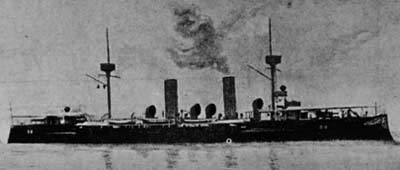
Hai Yung circa 1900
Post-revolution service
Hai Yung served after 1911 for the Chinese Republic with most of the Navy, but funds were lacking and the ships needed maintenance. In January 1912, the Provisional Government of the Republic of China ordered the Northern Expedition with the Hai Yung class under Tang Xiangming, commander of the Navy at its head. On January 16, 1912, they sailed to Yantai, which had declared independence.
The second revolution broke out in 1913 and in July the Beiyang Fleet was led by Commander Li Dingxin, assisted by Zheng Rucheng, deputy of the Navy Guard. They were sent to resist Yuan Jun’s attack. In August Zhang Xun and Feng Guozhang attacked Nanjing and Liu Guanxiong dispatched Hai Chi and Hai Yung to shell the Lion Rock Fort while the Beiyang Army launched a general offensive.
After the end of the Second Revolution the Department of the Navy decided to modernize the fleet and adopted the Siemens Telefunken 2.5TK radio which allowed a 1700 km range. Former Marconi systems was installed on the Nan Chen. In addition, the old bow dragon pattern decoration of the class and other ships was removed and the aft battle mast removed to lower the center of gravity while its pedestal bas was reserved for use as a maintenance platform.
The Hai Yung class during WWI
At the end of July 1914, Japan was likely to declare war on Germany and both Hai Chi and Hai Yung were stationed in Yantai. On December 25, 1915, the Yunnan became independent and a new civil war broke out. In April 1916, the Beiyang Army requisitioned the Hai Yan, Xin Ming and Xin Yu to carry the 12th Division to Fujian, while Hai Chi and Hai Yung provided escort. However on April 20, when the fleet passed Wenzhou in heavy fog, Hai Yung collided with Xin Yu. The captain and two electricians survived but the entire crew and more than 700 army officers and soldiers drawn that day as the ship, rammed and broken in two, sank quickly. It happened off Fuchow and the cruiser needed extensive repairs.
On July 1, 1917, Zhang Xun was restored while Hai Chou and Hai Yung, were ordered by Cheng Biguang to sail to Tianjin, planning to return there with Li Yuanhong but the misson failed. In July Cheng Biguang led fleet southwards and Haip Chou, Hai Yung, were persuaded by the Duan Qirui government to remained under the Beijing government authority and not follow Cheng Biguang. In August the Beijing government declared war on Germany so both cruisers participated in the confiscation of German and Austrian ships stranded in China.
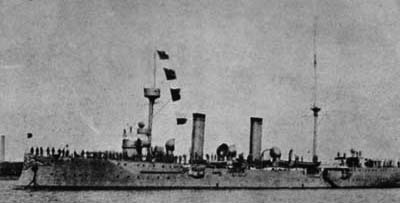
Long after the outbreak of the October Revolution in Russia, civil war was spreading and in 1918, Hai Yung was sent to join the entente intervention in Vladivostok in favor of white Russians and to maintain order. The Beiyang government also upgraded Hai Yung with a Long Wave radio station. The refitted cruisers departed from Shanghai on April 9, 1918, and arrived in Vladisvostock on April 16. in July she assisted the Russian Siberian Provisional Government Army against the Bolshevik assault, even sending sailors ashore to patrol. It was discovered meanwhile that radio range was unsufficient. Messages were relayed by an US warship. At the end of July 1918, Lin Jianzhang, captain of the Hai Yung was appointed navy general.
On May 20, 1919, Hai Chou replaced Hai Yung in Vladivostok and the latter returned to Shanghai, sent in drydock in Jiangnan Shipyard for maintenance. On October 25, Hai Chou returned to Xiamen to monitor the law-enforcement army and was replaced in turn by Hai Yung.
Interwar period

On July 5, 1920, the U.S. Intervention Army held a five-nation military alliance including China in Vladivostok and after the Soviets established the Far East Republic, the intervention forces withdrew one after another, Hai Yung returning in November. In April 1922, civil war broke out again. Commander of the Second Fleet Du Xigui and Lin Jianzhang disputed what line should be protected. Zengzhen Bing ordered Hai Chou, Hai Yung and Yong Ji north to assist the second fleet at Qinhuangdao, supporting an assault against Fengjun. The Northern Expeditionary of Army Xu Chongzhi retreated to the border between Fujian and Jiangxi and later Xu Shuzheng was sent to negociate with with Sun Yat-sen. Later one the government asked the Navy Department to investigate Li Houji and First Fleet Commander Zhou Zhaorui onboard Hai Yung send a Marine Corps to Fujian, while the training fleet (Yang Jingxiu) was sent to capture the Longmen Fortress. In July 1923 Yang Shuzhuang landed Marines to attack Zang Zhiping Department, Xiamen Army in Anhui without success. In June 1923 steamship Shenzhou Maru from the Kobe East Steamship Co., collided with Hai Yung and the Chinese claimed 6,700 yuan denied by the Japanese captain, which appealed to the Japanese Consulate in Fuzhou., which confirmed his position Anti-Japanese sentiment grew on, but to avoid a war, compensation was ultimately paid.
In April 1923, the cruisers had their electrical installation modernized in Shanghai with alternative current. In 1924, the Jiangsu-Zhejiang War broke out and Qi Xieyuan tried to unify the navy by force. Commander Du Xilu tried to led the first and second fleet to cooperate and in September the battle rage near Huangdu, west of Shanghai with the fleet stationed in Fujian confronting the Shanghai navy. The Shanghai fleet was later captured by Du Ximin. In July 1926, the National Revolutionary Army captured Wuchang. Wu Peifu suffered heavy losses and later the Navy began negotiations with the Kuomintang.
After Chiang Kai-shek’s promises, the Central Fujian Navy resigned and in November the First Fleet in Fujian attacked. On February 1927, the Shanghai fleet participated in the second armed uprising of Shanghai workers. The Second Fleet (Chen Shaokuan) led the Hai Yung attacked Wusong Fort, and shelled the Liuhe area. Inn April the Navy was reorganized and the Hai Yung class cruisers formed the basis for the newly formed First Fleet. Its ommander Chen Jiliang, led the fleet to defend Wusong in Jiangyin. In May Hai Yung and Hai Chou went on patrol and forced Hai Chi to withdraw.
In 1928, Hai Yung’s hotchkiss guns were replaced with four Vickers 6-pdr (47mm guns) and four 3-pdr (37mm guns) and later, a single Vickers 40 mm (2-pdr) AA was installed. In 1929, the Jiang Gui War broke out and in May Hai Yung, Ying Rui, and naval gunboats escorted the army troop carrier from Wusong south, followed by landings in Shantou and Humen. In June 1933, the Xuejia Island incident broke out. Hai Chi, Hai Chen, Zhao He, and the three other ships defected from the Northeast Navy and turned to Chen Jitang. In July the Nanjing fleet (Chen Shaokuan) was ordered to sail to intercept three ships in Nantou. In June 1935, Hai Chi and Hai Chen left the Guangdong Army, defecting to join Hong Kong, avoiding an air attack of the Guangdong Army. The Central Navy performed an exercise off the coast of Fujian when Chen Jiliang led the First Fleet blockade Hong Kong. Hai Chi and Hai Chen left Hong Kong, under guns of Ning Hai, which fired warning shots, forcing them back. Ning Hai, Hai Yung, and Hai Chou entered Hong Kong during, asked the two ships to hand over their guns breeches to be disarmed and join the central navy northwards. They refused and the stalemate went on until the end of June, leading to a compromise. The two cruisers would be sent to Shanghai separately.
End of the Hai Yung class: The second Sino-Japanese war
When the Second Sino-Japanese War broke out in 1937, the Hai Yung class was out of date and in poor condition and on september 25, they were sunk as block ships in the Yangtze river.
The Admiralty prior to this mobilized the local fleets to conduct a three-month preparation exercise in Nanjing and in September the Military Commission ordered Hai Chi, Hai Chen, Hai Chou, and Hai Yung to form a blockading lined right in the Yangtze. Due to the hasty order, Hai Yung’s 150 mm were not removed, only one was salvaged but the 105 mm and lighter guns were all removed and put into storage. The AA guns ended on the gunboat Yong Sui. On April 25, 1959, the Shanghai Salvage Engineering Bureau salvaged the Hai Yung and dismantled her for scrap metal.


 Latest Facebook Entry -
Latest Facebook Entry -  X(Tweeter) Naval Encyclopedia's deck archive
X(Tweeter) Naval Encyclopedia's deck archive Instagram (@navalencyc)
Instagram (@navalencyc)





 French Navy
French Navy Royal Navy
Royal Navy Russian Navy
Russian Navy Armada Espanola
Armada Espanola Austrian Navy
Austrian Navy K.u.K. Kriegsmarine
K.u.K. Kriegsmarine Dansk Marine
Dansk Marine Nautiko Hellenon
Nautiko Hellenon Koninklije Marine 1870
Koninklije Marine 1870 Marinha do Brasil
Marinha do Brasil Osmanlı Donanması
Osmanlı Donanması Marina Do Peru
Marina Do Peru Marinha do Portugal
Marinha do Portugal Regia Marina 1870
Regia Marina 1870 Nihhon Kaigun 1870
Nihhon Kaigun 1870 Preußische Marine 1870
Preußische Marine 1870 Russkiy Flot 1870
Russkiy Flot 1870 Svenska marinen
Svenska marinen Søværnet
Søværnet Union Navy
Union Navy Confederate Navy
Confederate Navy Armada de Argentina
Armada de Argentina Imperial Chinese Navy
Imperial Chinese Navy Marinha do Portugal
Marinha do Portugal Mexico
Mexico Kaiserliche Marine
Kaiserliche Marine 1898 US Navy
1898 US Navy Sovietskiy Flot
Sovietskiy Flot Royal Canadian Navy
Royal Canadian Navy Royal Australian Navy
Royal Australian Navy RNZN Fleet
RNZN Fleet Chinese Navy 1937
Chinese Navy 1937 Kriegsmarine
Kriegsmarine Chilean Navy
Chilean Navy Danish Navy
Danish Navy Finnish Navy
Finnish Navy Hellenic Navy
Hellenic Navy Polish Navy
Polish Navy Romanian Navy
Romanian Navy Turkish Navy
Turkish Navy Royal Yugoslav Navy
Royal Yugoslav Navy Royal Thai Navy
Royal Thai Navy Minor Navies
Minor Navies Albania
Albania Austria
Austria Belgium
Belgium Columbia
Columbia Costa Rica
Costa Rica Cuba
Cuba Czechoslovakia
Czechoslovakia Dominican Republic
Dominican Republic Haiti
Haiti Hungary
Hungary Honduras
Honduras Estonia
Estonia Iceland
Iceland Eire
Eire Equador
Equador Iran
Iran Iraq
Iraq Latvia
Latvia Liberia
Liberia Lithuania
Lithuania Mandchukuo
Mandchukuo Morocco
Morocco Nicaragua
Nicaragua Persia
Persia San Salvador
San Salvador Sarawak
Sarawak Uruguay
Uruguay Venezuela
Venezuela Zanzibar
Zanzibar Warsaw Pact Navies
Warsaw Pact Navies Bulgaria
Bulgaria Hungary
Hungary

 Bundesmarine
Bundesmarine Dutch Navy
Dutch Navy Hellenic Navy
Hellenic Navy Marina Militare
Marina Militare Yugoslav Navy
Yugoslav Navy Chinese Navy
Chinese Navy Indian Navy
Indian Navy Indonesian Navy
Indonesian Navy JMSDF
JMSDF North Korean Navy
North Korean Navy Pakistani Navy
Pakistani Navy Philippines Navy
Philippines Navy ROKN
ROKN Rep. of Singapore Navy
Rep. of Singapore Navy Taiwanese Navy
Taiwanese Navy IDF Navy
IDF Navy Saudi Navy
Saudi Navy Royal New Zealand Navy
Royal New Zealand Navy Egyptian Navy
Egyptian Navy South African Navy
South African Navy






























 Ukrainian Navy
Ukrainian Navy dbodesign
dbodesign